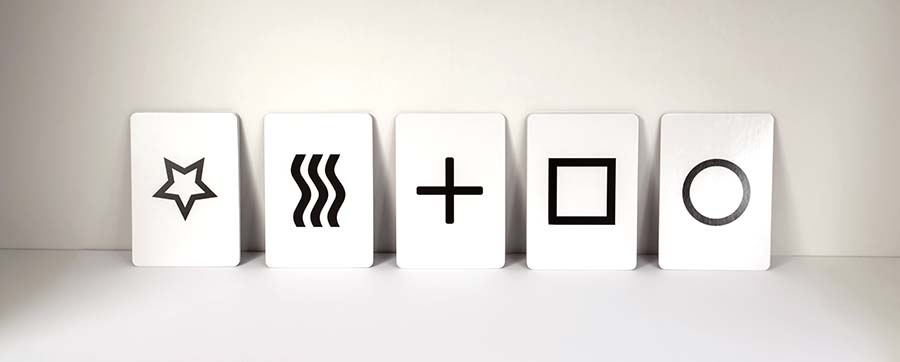One deck of cards, five simple symbols; guess all the cards to determine if you have psychic powers. But did the experiments conducted with these cards really provide scientific proof that psychic abilities really exist? How did an astronaut attempt this test from space? And why did Karl Zener try for years to remove his name from the deck of cards that would forever be associated with extra-sensory perception tests?
In this episode of Homespun Haints, we explain the history of these ESP cards. We’ll also talk in-depth about the lengthy (and oft hilarious) research trials that went into psychic ability at Duke University during the 20th century.
[podcastplayer feed_url=”https://www.spreaker.com/show/5199458/episodes/feed” filterby=”What Are Zener Cards” accent_color=”#9D6E3C” hide_download=”true” apple_sub=”https://podcasts.apple.com/us/podcast/homespun-haints/id1464464952?mt=2&app=itunes” spotify_sub=”https://open.spotify.com/show/6z2RNMlMad1f5Q45hbaxXA” google_sub=”https://podcasts.google.com/feed/aHR0cHM6Ly93d3cuc3ByZWFrZXIuY29tL3Nob3cvNTE5OTQ1OC9lcGlzb2Rlcy9mZWVk”]Short Description [/podcastplayer]
AI-generated transcript available upon request.
What are Zener Cards Anyway?
These cards were invented by Duke professor and perceptual psychologist Karl Zener to aid parapsychologist J. B. Rhine. Rhine’s psychic research on ESP is an example of how an experiment can give us years of data without enhancing our understanding of the subject matter one iota.
What are the five designs on a deck of Zener cards?
Zener cards have five designs: a cross, a hollow circle, a hollow square, a hollow five pointed star, and three vertical wavy lines. A deck of Zener cards has five of each design, so twenty-five cards in total.

Who was Joseph Banks Rhine in Psychic Research?
Dr. J. B. Rhine grew up as a Midwestern Christian farm boy. Originally, he wanted to go to divinity school. His wife was amore practical person (maybe?), and she talked him into studying science instead by arguing, “it’s the wave of the future, Joseph.”
So they moved to the city and they both started studying botany. As their interest in nature science grew, they began to wonder how they could use scientific tests to determine the answer to “life’s big questions” that they had pondered in their very religious upbringing.

One thing led to another, and eventually, they began testing psychic abilities. Rhine even coined the term “Extrasensory Perception.” Rhine approached a colleague of his, Zener, and asked him to develop a pack of cards he could use for tests.
The Zener Test Era
For the next three decades, Rhine tested thousands of students for psychic abilities in his Duke University lab, with funding from private donors and the U.S. Government. The public grew so interested in his experiments that astronaut Edgar Mitchell agreed to conduct psychic ability experiments for him while in space aboard the Apollo 14.

How Does a Zener Card Test Work?
Rhine’s psychic ability test involved subjects predicting the symbols on Zener cards. Basically, the experimenter picks a zener card from a shuffled pack, and looks at it, very seriously. The person being tested concentrates on reading the mind of the experimenter, using psychic abilities alone to get an idea of the symbol on the one card from the Zener Card pack that the experimenter is holding. The subject is told if his symbol guess is correct or not, then the experimenter continues to draw the next card and the subject being tested continues to attempt correct guesses.
Since the test subject is expected to guess the cards with no data or hints, the statistically expected outcome of the test would be equivalent to random guessing, right? Well, some subjects scored above random chance, making their test results statistically significant. This statistical analysis of the results was crucial in evaluating the validity of psychic abilities.
Does the Zener Card Test Prove Psychic Abilities?
Unfortunately, the early Zener Card ESP tests had several design flaws.
Rhine’s experiments used a hand-shuffled pack of Zener cards; poor shuffling of the cards could lead to greater predictability of the next draw in line. Informing subjects if their guesses were correct could increase their accuracy through card counting. Some tests were conducted in poorly controlled environments, like in a moving car. Further testing in future years attempted to control for these variables in several ways, with machine shuffling, etc, (but after seeing Ghostbusters, we’re doubting that all subsequent Zener Card users were as dedicated to hard science).
What Did We Learn From Extra Sensory Perception Zener Card Tests?
Even more disappointingly, the Zener Card test didn’t answer, or even begin to address, “life’s big questions.” At best, the Zener Card Test can merely determine if the test subject has psychic abilities. It provides no insight into how one might become psychic, or improve their psychic abilities.
After thirty-odd years of Zener Card experiments yielding no valuable information to the US government, funding for Duke Parapsychology Laboratory dried up in 1965. The organization restructured as a nonprofit, called the Rhine Research Center. Also, you can still buy Zener Card decks today, either with real cards or trick cards, depending on how much you trust your psi abilities, and how much your friends trust you.
Listen to the episode to learn more about extrasensory perception
For the hilarious and in-depth history of psychical research and J. B.Rhine, listen to our episode! And have a spooky day!
